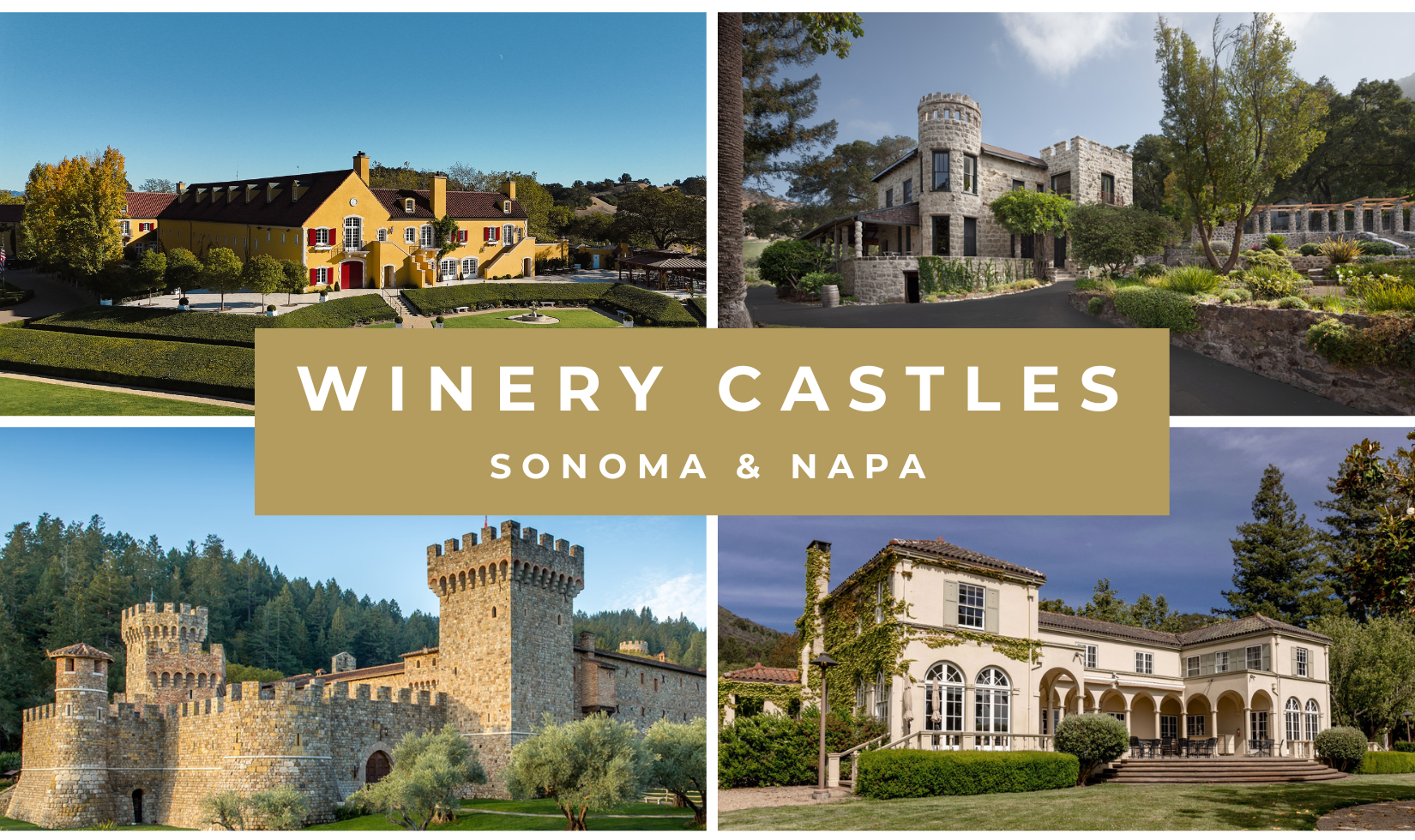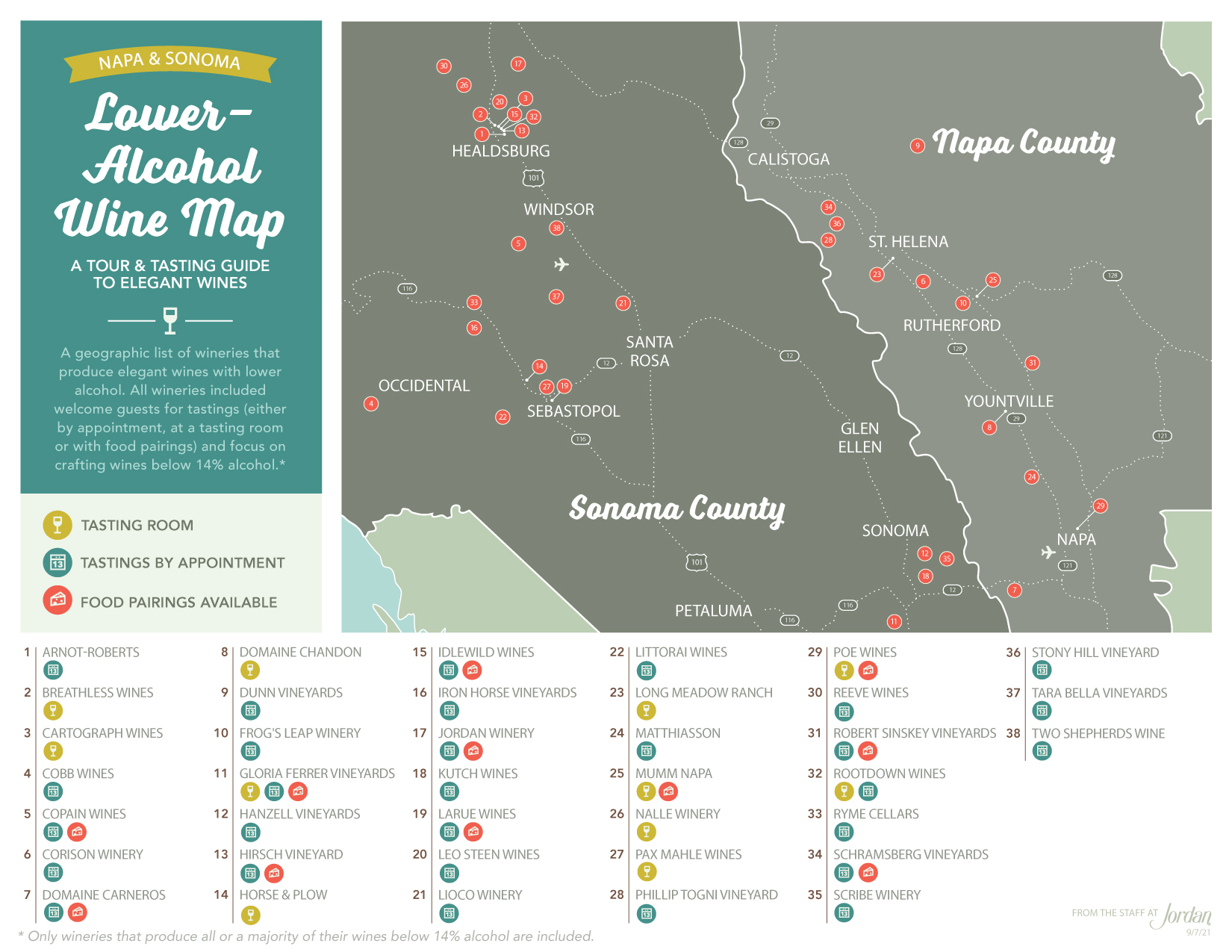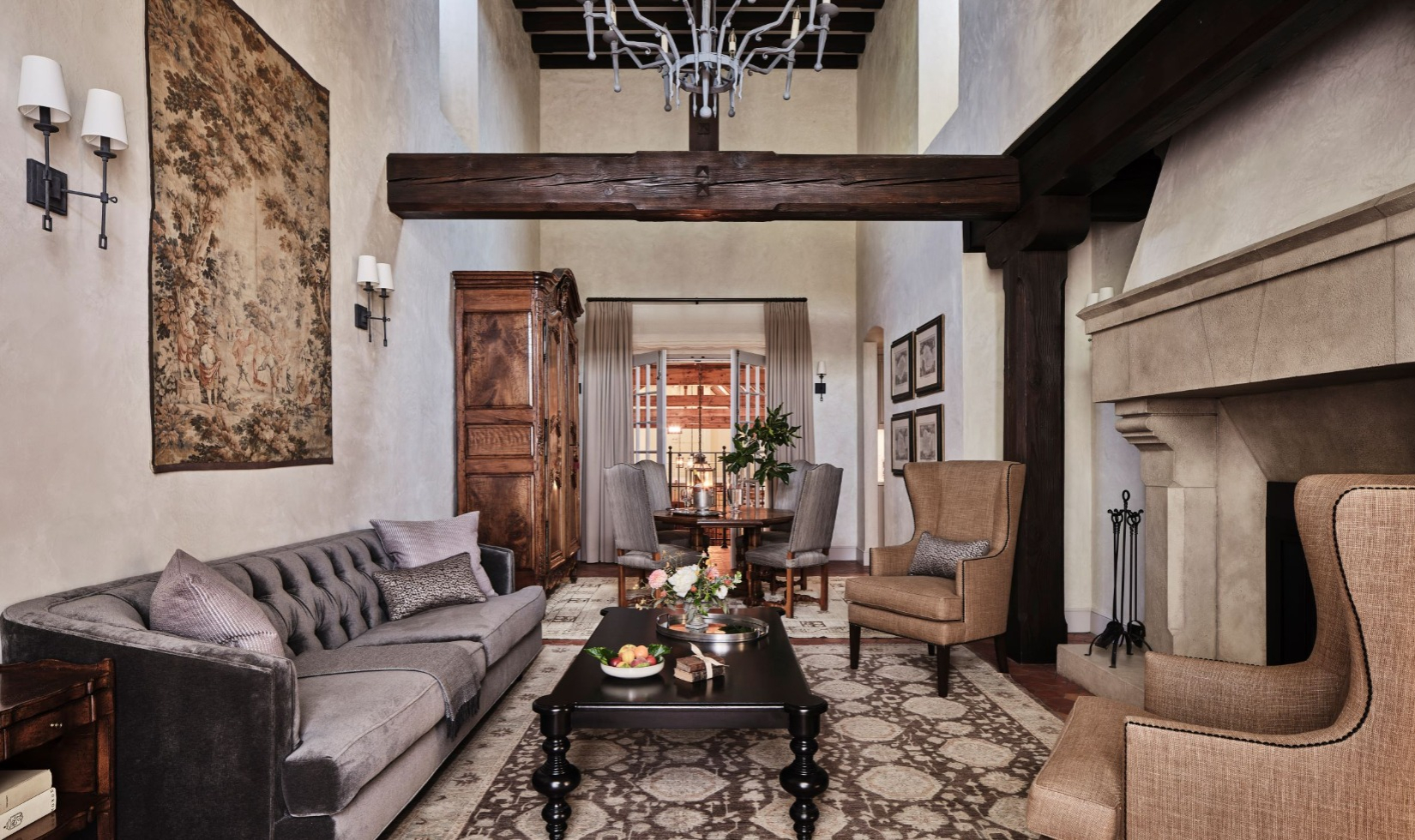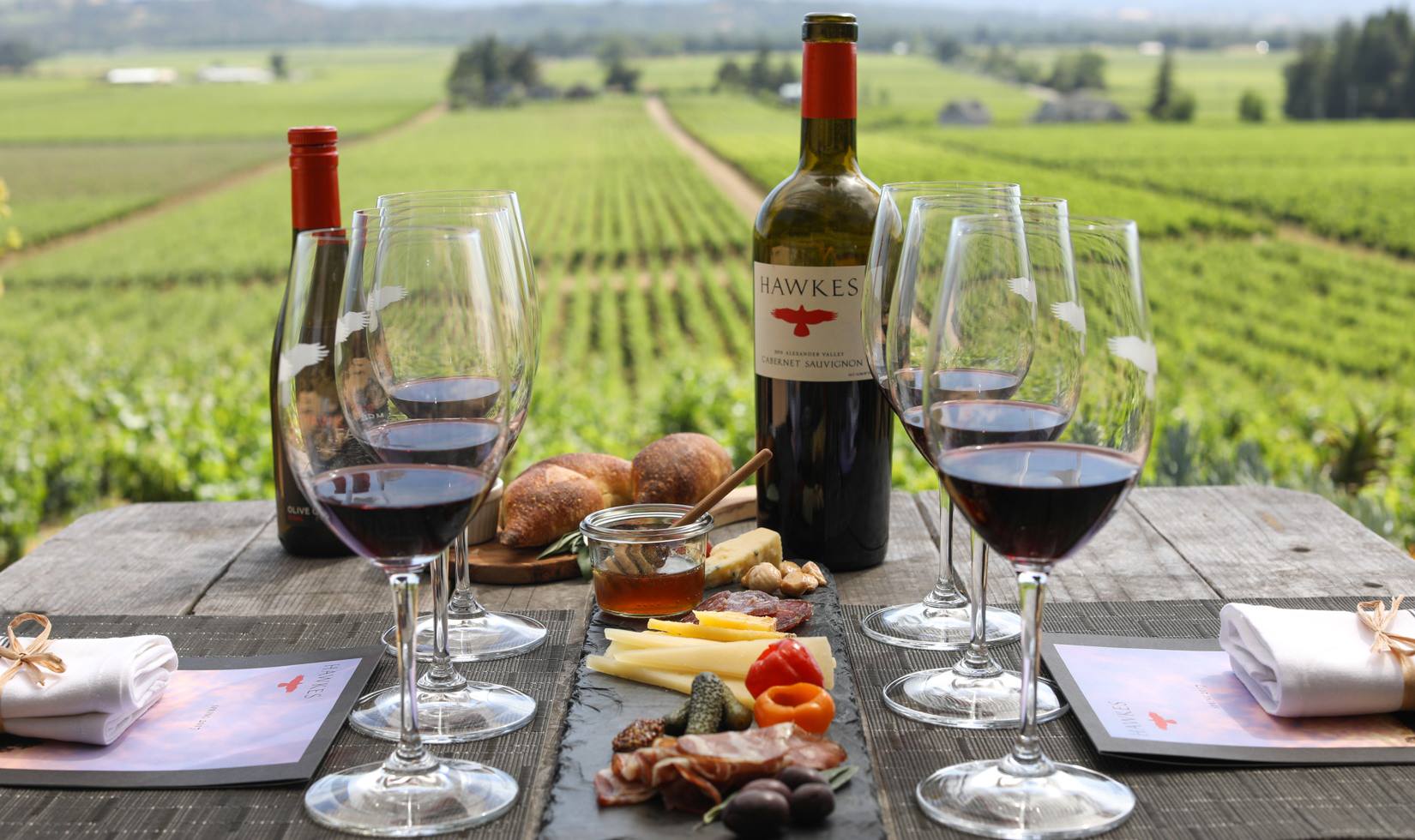Many gorgeous tasting rooms dot the land in California wine country but to really amp up the wow factor, Napa and Sonoma winery castles are the sights to see. The history of the winery castle harks back to the grandiose chateaux (“castle” in French), deeply ingrained in French winemaking history, especially Bordeaux. The stunning winery castles in our backyard, however, draw inspiration not only from France, but also Italy and Iran. Here are nearly a dozen winery estates across Napa and Sonoma counties that honor Old-World architecture in grand ways, and look like castles. These destinations are organized geographically by region, north to south and south to north, to aid in itinerary planning.
Sonoma Winery Castles (Updated March 2025)
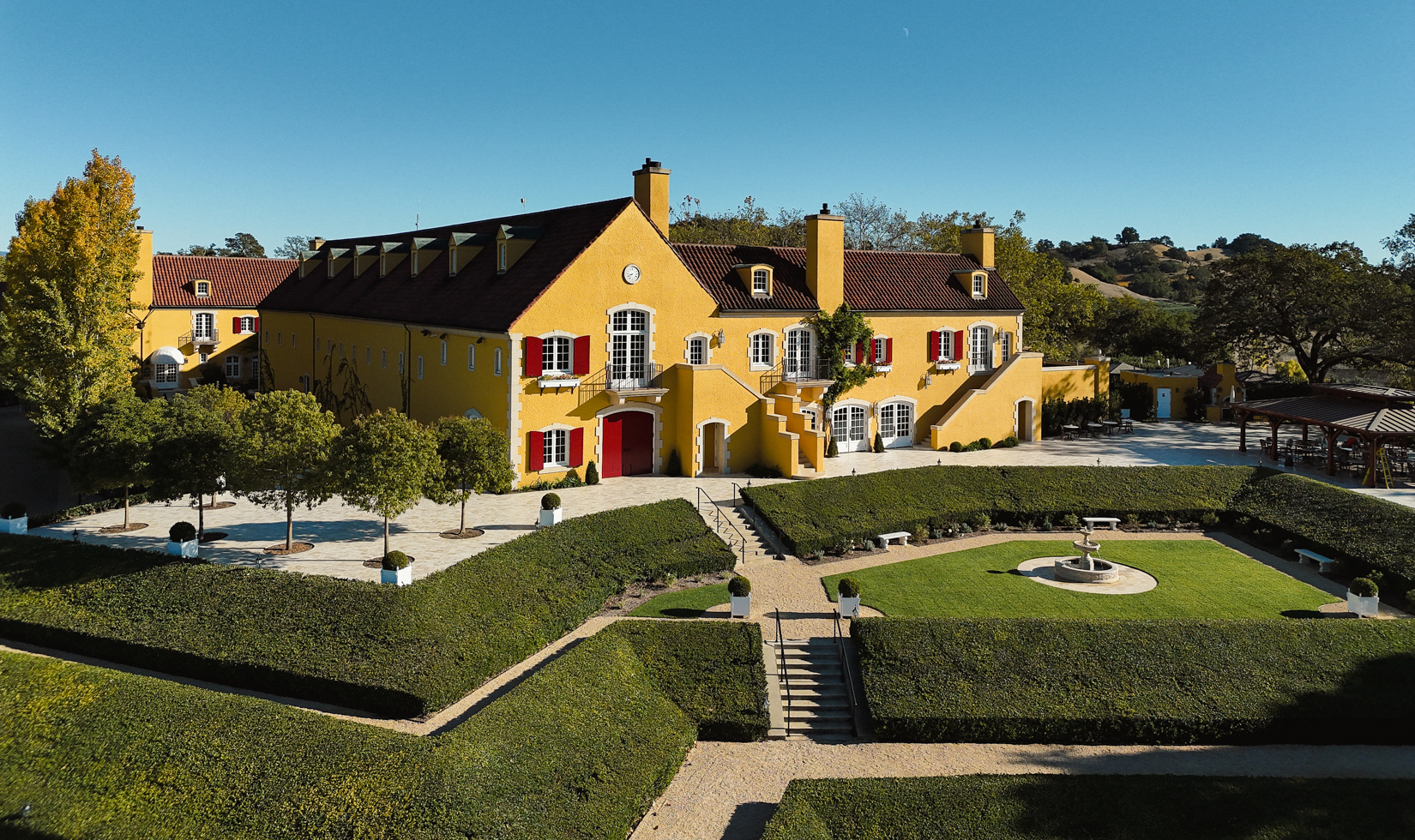
Jordan Vineyard & Winery
In 1974, Tom and Sally Jordan turned their attention from winegrowing to building a magnificent winery near Healdsburg—a chateau that would combine food, wine and hospitality in such a way that visitors would feel as if they had traveled to France without leaving California.
The Jordans had visited France often and particularly appreciated the wines and wineries of Bordeaux. They pored over books on French architecture and hired San Francisco architect Bob Arrigoni to realize their vision. They broke ground on the 58,000-square-foot French-inspired chateau in 1975, and the production wing of the winery—including 12 towering 6,000-gallon oak casks—was finished one week before the first harvest in 1976.
Today, guests will see a largely unchanged chateau façade, though the interior spaces were renovated from 2020 to 2024 to further enrich the guest experience. Under one crowning roof, visitors will find an elegant dining room overlooking the oak cask room, an open kitchen and chef’s table abutting the cellars, luxurious guest suites that open to the barrel rooms, and a lovely lobby and secluded tasting room steps from the fermentation tanks. Guests can explore the Winery Chateau through the Jordan Winery Tour & Tasting, which features wine tastings with chef-prepared food pairings and a walking tour through the iconic chateau. The winery also offers the A Taste of Jordan experience that includes a 45-minute wine and food pairing in the charming Library and Cellar Room, filled with French antiques. An added bonus: All food pairings are presented by a member of Jordan’s culinary team to add their award-winning, high-touch hospitality program.
Like many French chateau models, the land at Jordan is used not just for grape-growing and winemaking, but also self-sustaining activities such as fruit and vegetable farming, housing bee hives for honey, harvesting their olive trees for oil production, and chickens laying eggs for the Jordan culinary team

Ferrari-Carano
Italian Americans Don and Rhonda Carano, founders of Eldorado Casino Resort in Nevada, designed their dream winery in the 1980s as an homage to Italy. Known as Villa Fiore (“House of Flowers”), its arched windows, manicured gardens, central fountains and towering columns evoke the grand elegance of neoclassical architecture from 18th-century Italy and France. Inside, the sprawling, 25,000-square-foot villa lies the heart of Ferrari-Carano hospitality with several different experiences and settings, created by new owners, Bill and Carol Foley of Foley Family Wines & Spirits. Reserve Tastings are offered in the remodeled Salon, a stylish living room, and brunch is hosted on weekends in the Villa’s dining room or the sweeping terraces, overlooking the vineyards, a grove of sycamore trees and the gardens. Downstairs, adjacent to the wine cellar filled with hundreds of barrels, the stone-walled Enoteca wine lounge sets the stage for the Molto Bene Wine & Food Pairing, featuring dishes by Celebrity Chef Nadia Caterina Munno, aka The Pasta Queen. Outdoors, guests can reserve a Pergola Tasting and enjoy the views surrounding the winery’s serene fountain—as long as a hotel swimming pool.
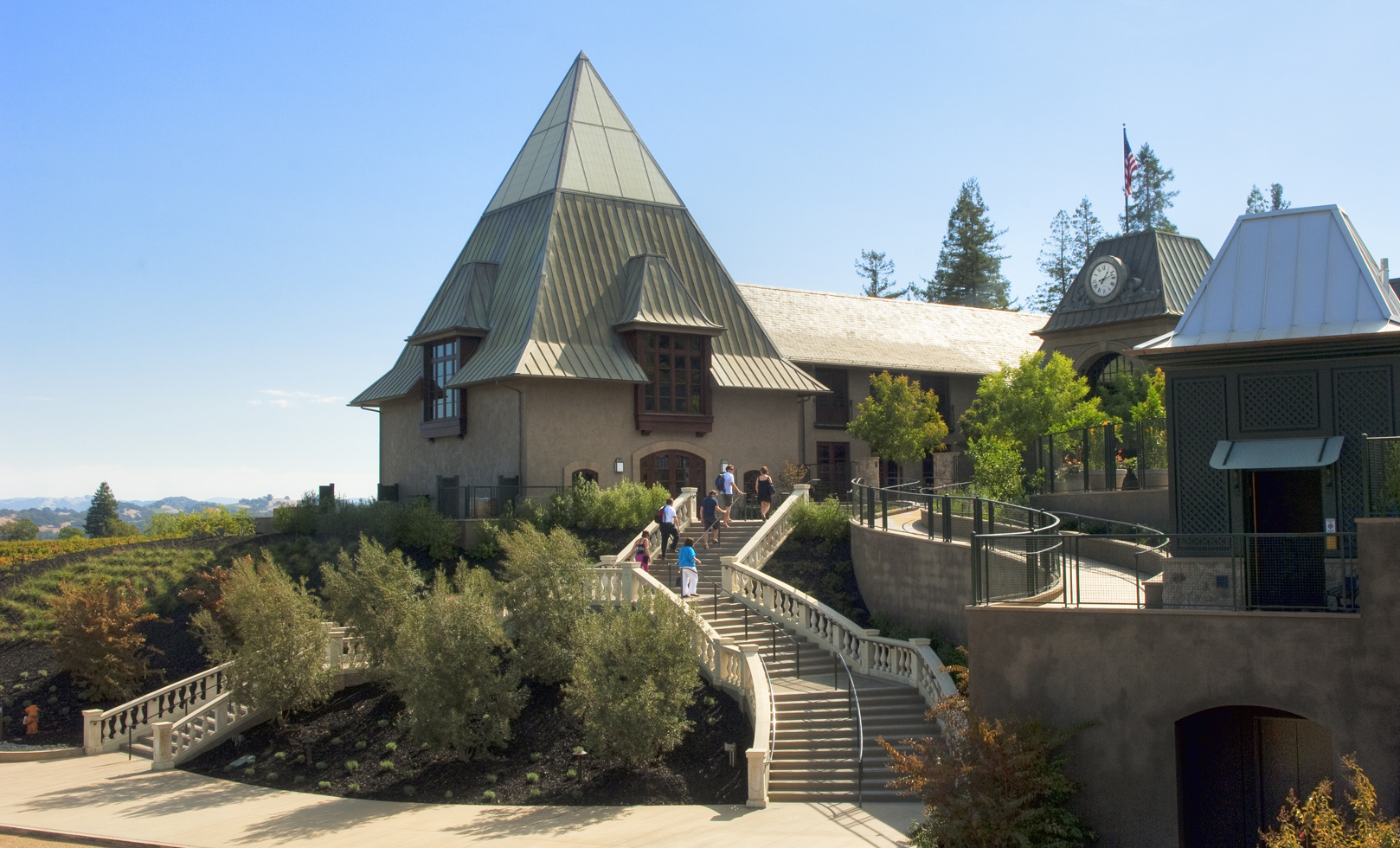
Francis Ford Coppola Winery
To create this Sonoma winery castle in the northern hills of Alexander Valley, architect John Marsh Davis combined a French country-style chateau with two towers representing a modernistic take on Sonoma’s old hop kilns. Built in the 1980s as Chateau Souverain, the storybook structure included an ambitious, California-French restaurant whose opening chef was none other than Gary Danko, now known for his eponymous restaurant in San Francisco. After a decade of ownership changes, movie producer/director Francis Ford Coppola and his wife, Eleanor, purchased the estate in 2006 and renamed it after the movie mogul. They transformed Francis Ford Coppola Winery into a family-friendly playland, with multiple tasting areas, pools, cabanas and movie memorabilia to explore—and a new restaurant concept, Rustic, serving classic Italian favorites. (Coppola sold the majority of his Alexander Valley winery to another prominent Italian-American winemaking family, Delicato, in 2021—reportedly to help fund his sci-fi opus, Megapolis.)
Coppola has retained a minority stake in the winery, and the exterior architectural features of this Sonoma winery castle remain a sight to behold. While many of the indoor and outdoor hospitality areas have been renovated in the last two decades, the four-sided, sloped mansard-roofed buildings of French origin remain, their pyramid tops scraping the Alexander Valley sky. The grand staircase leading from the parking lot to the visitor entrance should have a selfie stop sign.
The Delicatos have expanded Rustic restaurant’s menu beyond pizzas, pizzas, salads and roasted meats to include South American-inspired dishes prepared on the chef’s parrilla. Beyond day passes at the pool and impromptu wine tastings at the main bar, FFC offers wine and cheese tasting, wine and bocce experiences, and both hosted and self-guided tours.

Ledson Winery & Vineyards
Steve Ledson originally designed this massive Sonoma winery castle as his residence in 1993. But he changed his mind, converting it to a visitor destination that includes three tasting bars, multiple tasting suites for private experiences, wedding space, a room for special events and a marketplace deli for those seeking sustenance to take home. Guests are also welcome to picnic at the winery’s grove of oak trees.
Ledson’s design, a modern take on Gothic, French Normandy architecture, has eye-popping towers and turrets, set off against a steep slate roof. Inside are massive staircases, marble fireplaces, indented coffered ceilings and more than five miles of wood inlay, hand-cut and installed by Ledson’s son, Mike.

Chateau St. Jean
Built in the 1920s by a family of wealthy Michiganders, Chateau St. Jean’s winemaking story began in the 1970s, when three Central Valley grapegrowers—united through marriage—decided to pursue a dream of making fine wine. Ed Merzoian, his wife, Jean, his brother, and her brother named their winery after Jean—the force who linked their families, known for her elegance, charm and love of hospitality. Together, they transformed the chateau estate into a working winery and created what would become an early American wine icon, thanks to its commanding architecture, welcoming atmosphere, Cinq Cépages Bordeaux blend and single-vineyard chardonnays. They even offered VIP guest accommodations in their wine country castle for a period of time, after the winery itself was completed in 1980.
Though ownership changed a few times during the first half of Chateau St. Jean’s story, the winery has been part of Bill Foley’s family of wineries since 2020. His shared passion for hospitality has allowed Chateau St. Jean to evolve into an even more dynamic destination for experiences and events amid enchanting grounds. The neoclassical architecture features of the two-story house remain an attraction—arched windows, loggias and sweeping terraces that spill into gorgeous gardens. Guests can enjoy the chateau by reserving one of three elevated tastings: the Cinq Cépages Vertical Tasting, the Chateau Experience or for larger groups, the Chez Nous Reserve Tasting. Other experiences, including bocce, lunch and pure wine tasting—are hosted outdoors with vineyard and rose garden views or in the French-inspired visitor’s center, constructed in 2000.
Napa Winery Castles
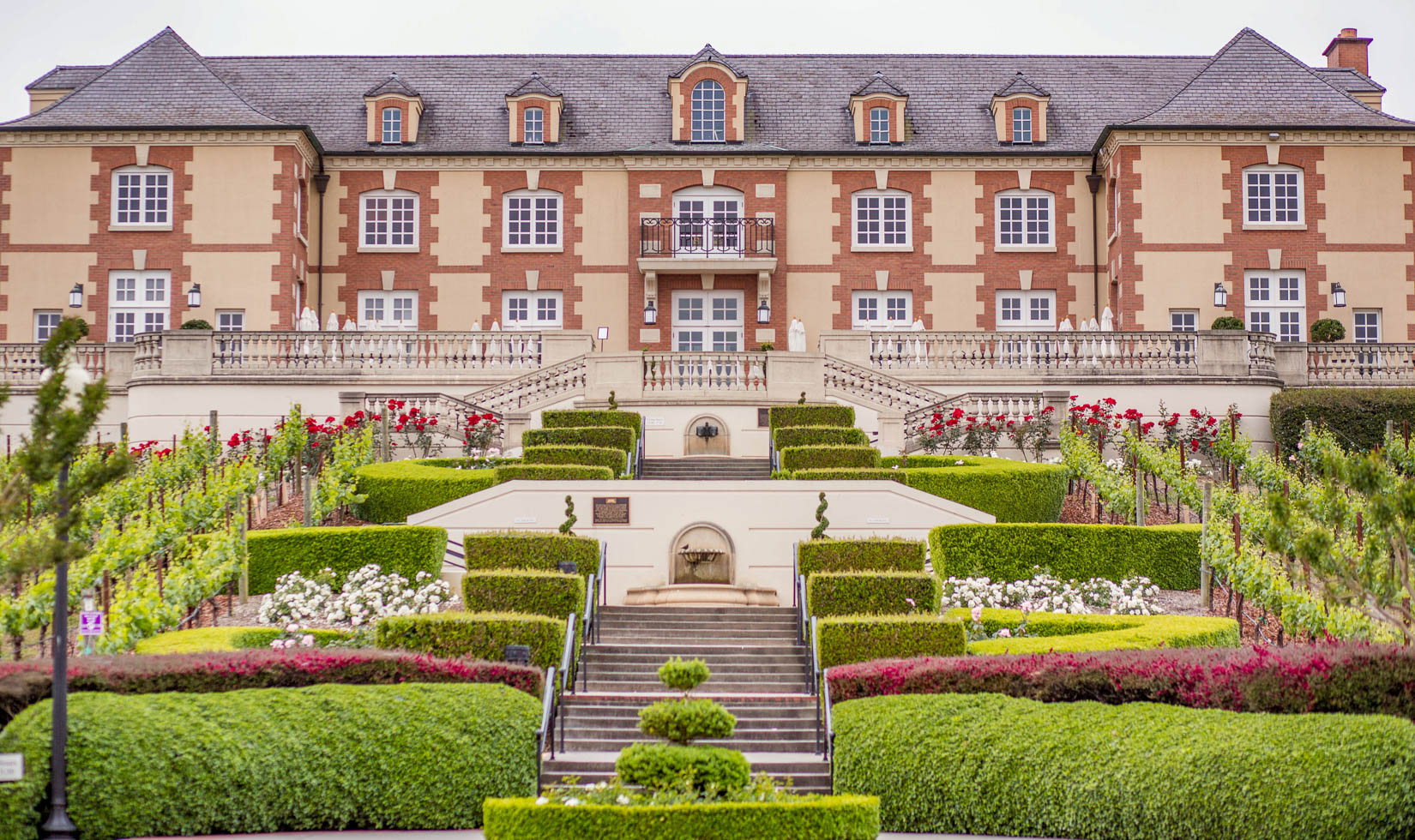
Domaine Carneros
To satisfy a desire to make sparkling wine in America, the Taittinger family of France’s Champagne region built Domaine Carneros in the late 1980s. Situated in the rolling hills of Carneros, the winery building was inspired by the 18th-century Château de la Marquetterie in France, greets drivers as they pass between Napa and Sonoma on Highway 12. This chateau is an impressive, hilltop structure surrounded by its own vineyards and those of other producers.
Designed by Napa’s Valley Architects, this homage to the French chateau boasts a grand staircase, bountiful gardens, magnificent patios with serene views, an elegant brasserie-style tasting salon and a new speakeasy-inspired lounge, unveiled in 2024. Just below a hidden staircase, Salon des Rêves offers guests an Art Deco atmosphere for sipping on their suite of elegant sparklers paired with other luxurious tastes, from oysters and tinned branzino to domestic and imported caviar. During winter months, guests can experience the Plat des Perles seafood and sparkling pairing in the new lounge, but the swanky space is also available for private events, including brunch. Five other tastings await upstairs, as well as Plat des Perles on the patio for those who prefer alfresco tastings. Whether you’re in the mood for caviar and wine tasting, their chef’s seasonal food pairings, charcuterie and cheese, or learning how to saber a bottle of sparkling wine, be sure to book in advance—and save room for the à la carte menu filled with French classics, such as gougères, rillettes and patés. Guided tours are offered with select experiences.

Darioush
Darioush and Shahpar Khaledi came to California in the 1970s seeking freedom and opportunity; they settled in Los Angeles with their two young children and, after leaving behind a successful engineering career in Iran, began their lives again. Darioush, a devoted collector of Bordeaux, had always dreamed of making his own wine; he was inspired by his upbringing in the city of Shiraz, Iran— the ancestral seat of winemaking dating back to 5000 BCE.
A natural entrepreneur, Darioush developed a successful independent grocery business that allowed him to pursue his ultimate dream of purchasing a vineyard. Though his first love, Bordeaux, was a strong contender, he believed he would find more freedom as a wine producer in Napa Valley. That dream became a reality in 1998 and after over five years of construction, the Khaledis opened their winery: an architectural homage to their homeland, inspired by the grand palace of Persepolis, the capital of the Persian Empire. They imported travertine from quarries close by Persepolis to build their 22,000-square-foot structure, with stunning hand-carved details. It houses a grand tasting salon, barrel chai with private tasting room, private residence including their underground wine cellar, a commercial kitchen, and even an amphitheater. Darioush opened its doors in 2004—a striking symbol of the foundational intersection of viticulture, hospitality, cuisine, and art that both Napa Valley and Persia share.
Guests are greeted by a series of towering columns and pomegranate trees before ascending to the grand salon with several tasting alcoves. <i>Taroof</i>, the Persian art of politeness, is infused throughout every experience with personal touches and friendly hosts who make everyone feel at home within such a commanding, chateau-style wine castle. The family’s emphasis on cooler-climate vineyards, noble French grapes, and organic farming creates wines with Old-World finesse, New-World freedom, and timeless flair. Food pairings are imaginative and unexpected, blending exotic ingredients with local produce, including some grown in their estate gardens. The Khaledis’ daughter, Sally, a licensed nutritionist and wellness advocate, works alongside her parents, bringing even more emphasis on balance, organic cultivation, and the culinary program. By Invitation Only offers guests a Michelin-inspired, food and wine pairing, while the Signature Mezze features Persian-style roasted pistachios and sharable seasonal fare perfect for pairing with their signature wines; they also offer elevated cheese and wine pairing, and a new sensory experience pairing caviar with their limited-release wines.
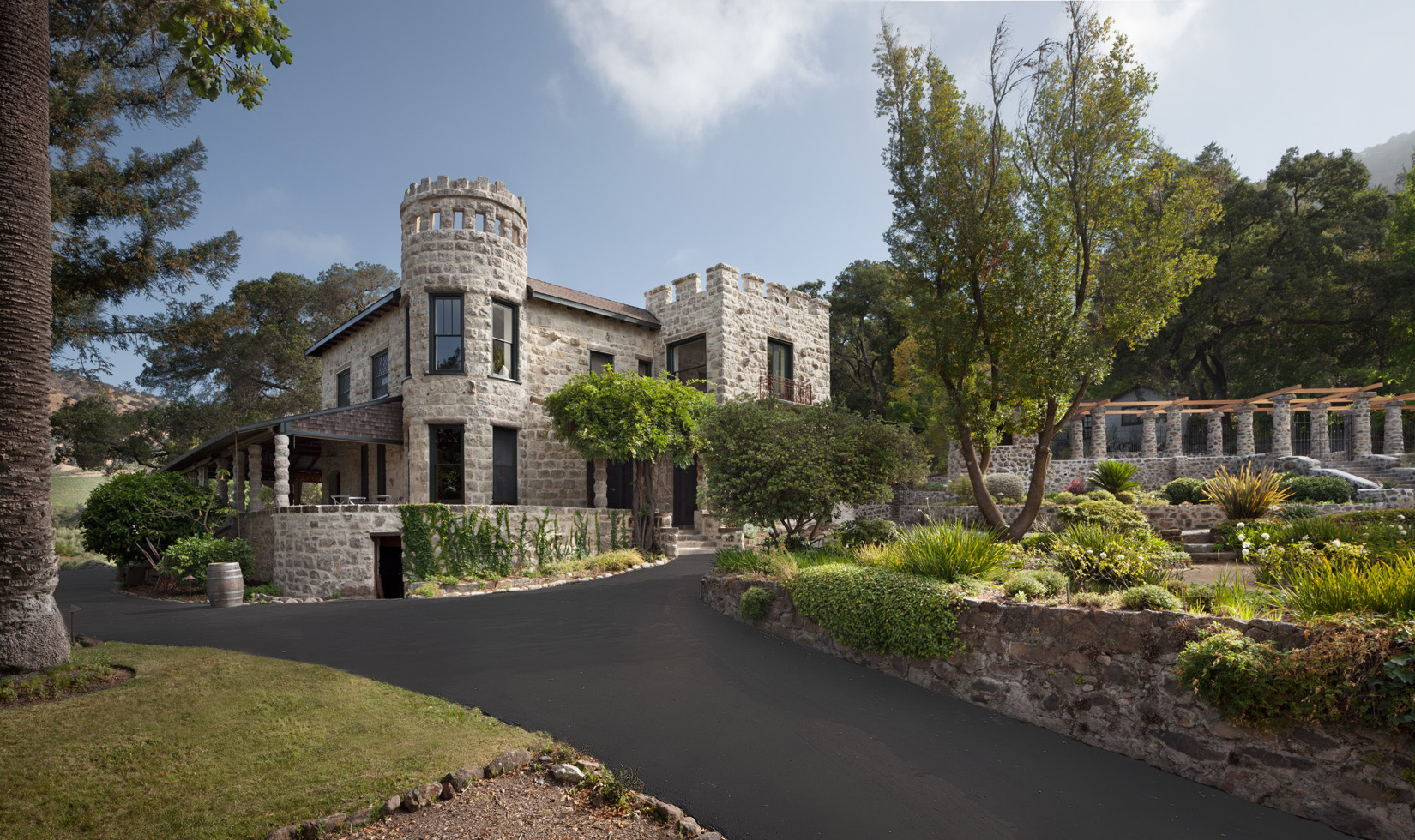
Stags’ Leap Winery
In contrast to the other Napa and Sonoma winery castles, Stags’ Leap does not feature a chateau. But this Napa stone winery qualifies for this list on the grounds that its Manor House, finished in 1891 by Horace Chase and his wife, Minnie Mizner, is a throwback to the days when agricultural properties with homes served as retreats for wealthy San Franciscans.
Chase partnered with his uncle, W. W. Thompson, to buy the land in Napa where grapes had been planted since the 1880s. The wine cave was blasted in 1893. Financial issues and Prohibition stalled their winemaking efforts, although there are stories that the Manor House became a speakeasy for gangsters and bootleggers in those adventurous times.
When Carl Doumani bought the property in 1971, he built up its winemaking business, and the Manor House was where he entertained visitors and the wine trade. The large, wrap-around porch was perfect for this, allowing guests to take in the view of the vines. Inside, the original fixtures, stained glass, huge fireplace and brooding ambiance speak to the gloried speakeasy days of the property. The winery has been owned by Treasury Wine Estates since 2000, who have continued to offer intimate, exclusive experiences to enjoy this historic property and its silky Stags Leap District wines.
Several guided experiences are available, all by appointment. Those who love to sip and savor the history of winery castles will enjoy the Manor House Experience, which features a walking tour and seated tasting, as well as the Porch Tasting, aptly named for its lovely setting, overlooking the grapevines. Legend says the place is haunted, though by a very friendly ghost.
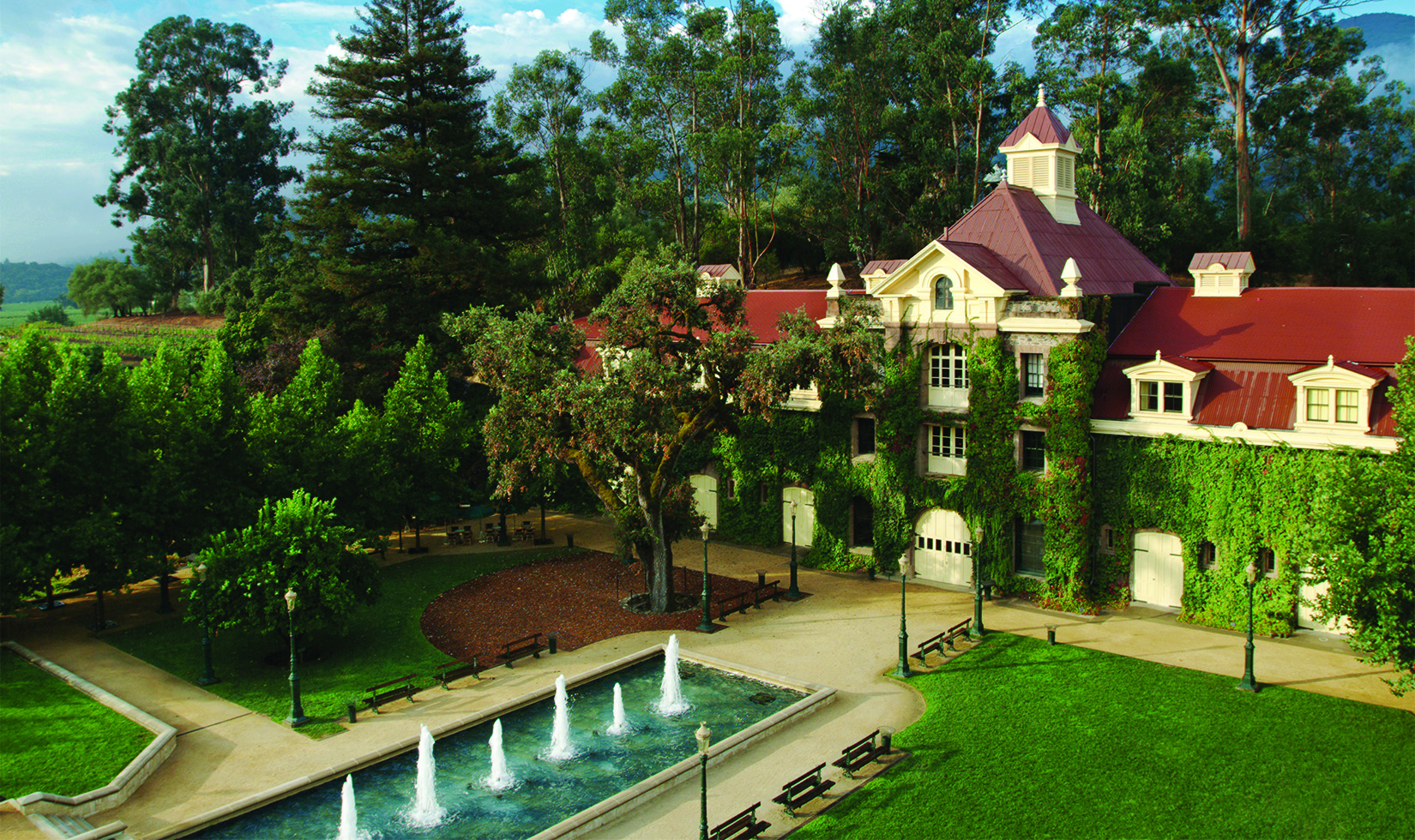
Inglenook
In the 1960s and early 1970s, Inglenook, under the winemaking direction of John Daniel, produced some of the most stunning cabernet sauvignons in California, wines of such character that they caught the attention of the Bordelais in France.
Gustave Niebaum, a wealthy Finnish sea captain, founded Inglenook in 1879 and commissioned William Mooser, a San Francisco architect, to design the great stone chateau in concert with Hamden McIntyre, who designed the winery. Construction began in 1881—yes, 1881—and the chateau stands proud today, under ownership of Francis Ford Coppola, who celebrates 50 years of winemaking in 2025.
Through various owners and names (Rubicon Estate and Niebaum-Coppola among them), Coppola returned the winery estate to its original name. In addition to the looming chateau structure, there is a reflecting pool graced by stately oaks and ample landscaped grounds for visitors (appointment only) to roam. The winery has been certified organic since 1994.
Several tour and tasting options are offered, and one of the most popular is the seated Legacy Tasting, featuring library wines and a tasting plate by the estate chef, hosted in the chateau’s Athenaeum. The Private Library Tour & Tasting includes a tour of the chateau and grounds, finishing with a tasting of estate wines with paired cheeses and charcuterie. There’s also a Bistro Experience during lunch hours.
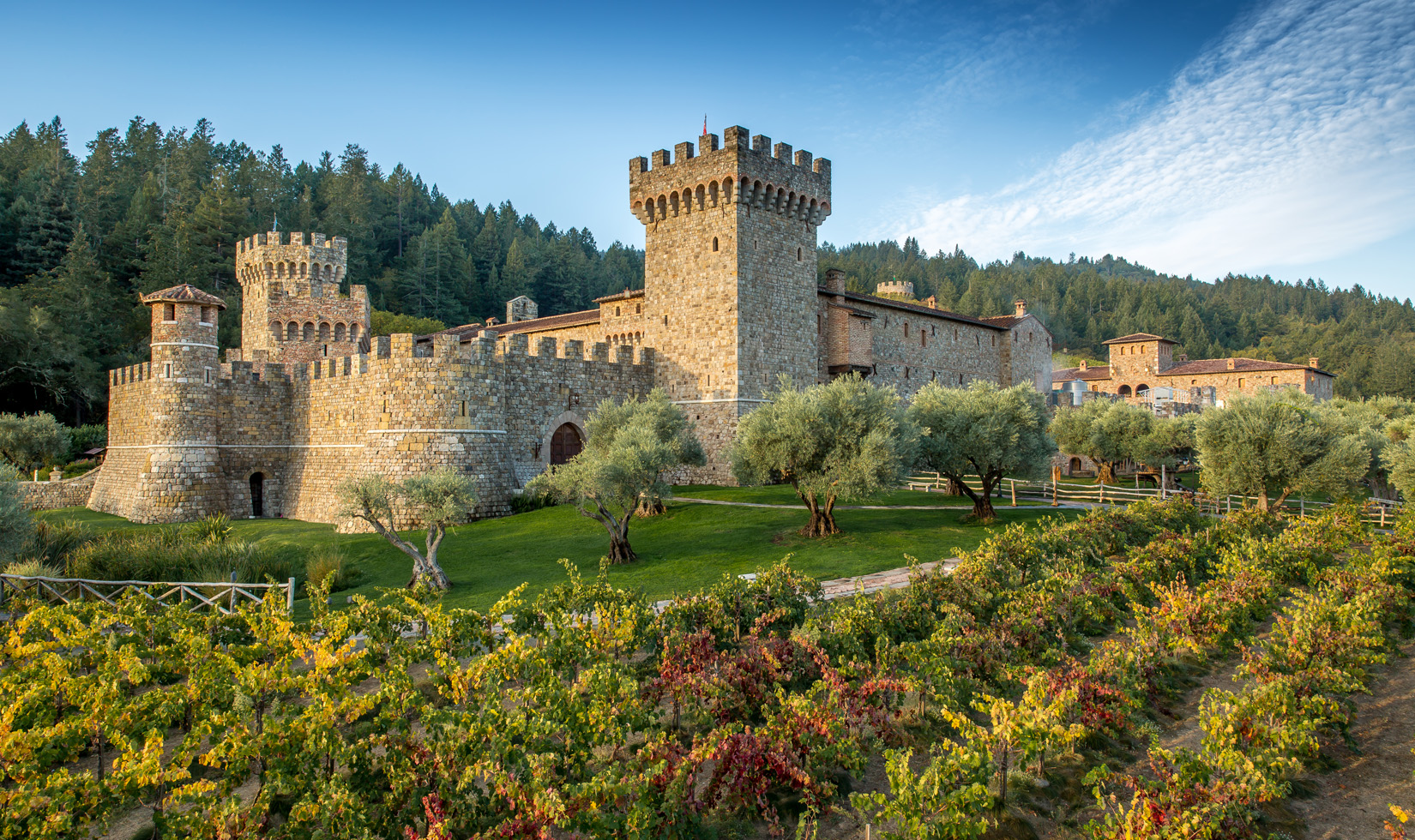
Castello di Amorosa
Italian immigrant Victorio Sattui founded a winery in St. Helena in 1885. His great-grandson, Darryl (known as Dario) Sattui revived the winery in 1976, which had struggled since Prohibition. The V. Sattui Winery tasting room and deli have found enormous success, offering small-production wines from grapes grown throughout Napa and Sonoma.
With this prosperity, Dario was able to scratch a larger itch: to construct a winery that spoke even more strongly to his family’s Italian roots. It took him several years to complete Castello di Amorosa in Calistoga, a replica of a 14th-century Tuscan castle, complete with drawbridge, dungeon and medieval dining hall. The 107-room castle is Disney-like, though Sattui paid attention to every detail, using 200-year-old bricks made from the Hapsburg dynasty in Europe and 2,000 custom Italian nails that anchor the oak doors of the great hall. It’s now widely known as the “Napa Castle,” and in 2024, was recognized as one of the top ten castles in the world by Tripadvisor.
Due to overwhelming fanfare, Castello di Amorosa is now open by reservation only. They offer an elevated charcuterie experience, though most tastings are purely wine with optional add-ons, such as chocolates and cheese. Wine selections also celebrate his Italian heritage, including barbera, sangiovese, pinot grigio and pinot bianco, yet there are also Napa Valley cabernet sauvignons, Russian River Valley pinot noirs and Anderson Valley gewürztraminers.
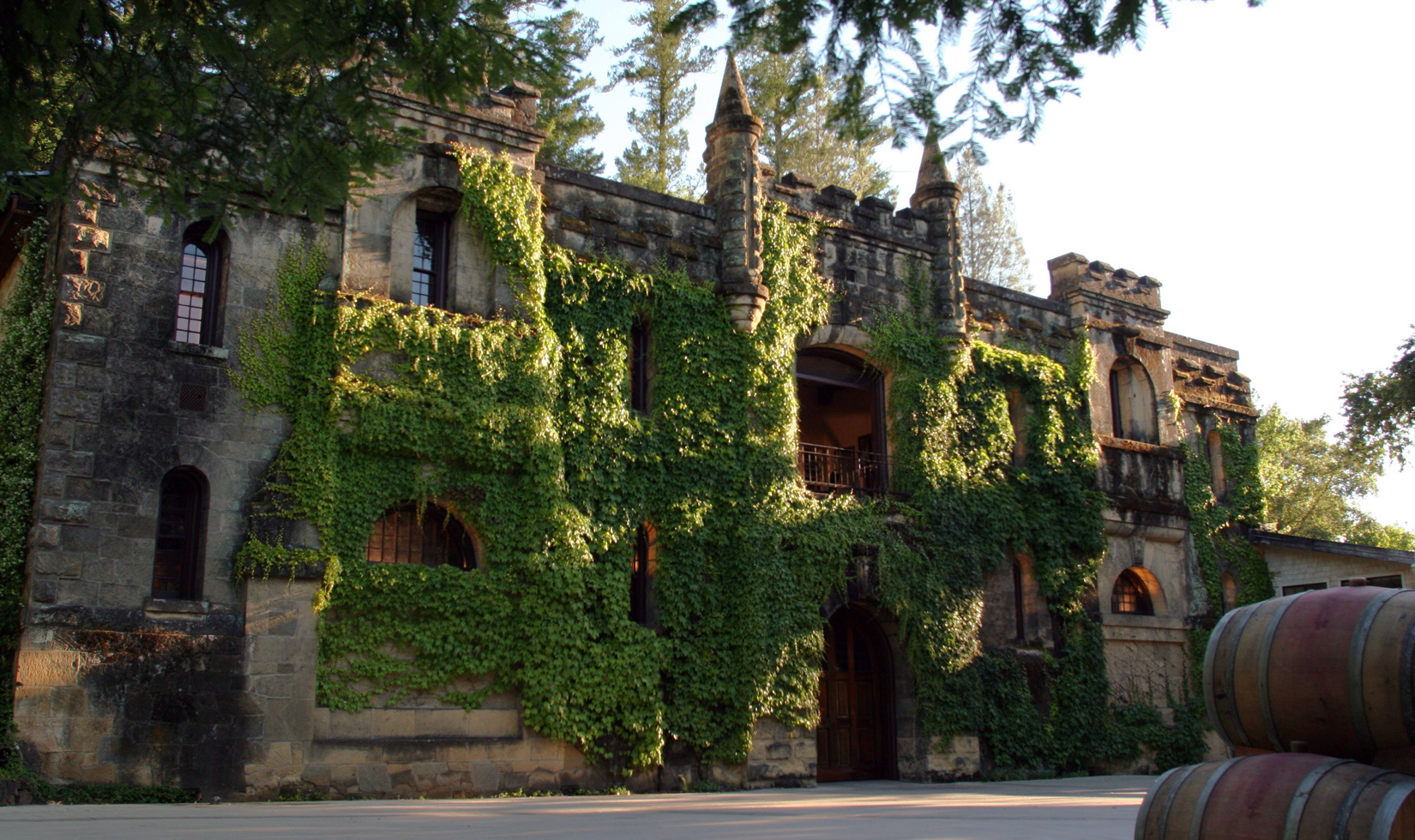
Chateau Montelena
The 1976 Judgment of Paris tasting put Chateau Montelena on the world wine map when its 1973 Chardonnay won first place in a blind evaluation among a panel of French wine critics. Yet the architecture alone is worth a visit to this historic Calistoga winery.
The English Gothic–style castle winery in Napa, built by the original owner, Alfred Tubbs, in 1888, has super-thick stone walls that provide year-round protection of wine from the elements. This, combined with its hillside location, regulates temperatures at the winery, beneficial in making and storing high-quality wines. The winery was non-operational from the early 1900s until 1972, when Jim Barrett purchased the property and resumed winemaking there.
Montelena offers an intriguing contrast of brooding stone edifices and the serenity of the Chinese garden and Jade Lake with its resident swan. Only club members have access to book a charcuterie and wine picnic by the lake. Tasting flights that feature sauvignon blanc, chardonnay, riesling, cabernet sauvignons and zinfandel start at $60. Walk-ins are welcome, though reservations are recommended.

